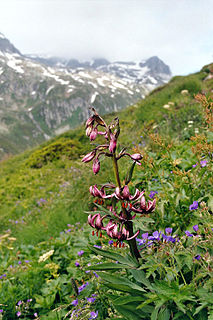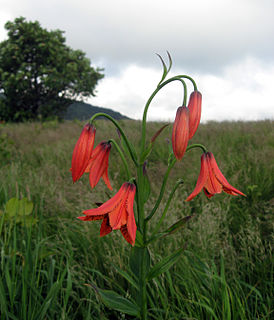
Lilium lancifolium is an Asian species of lily, native to China, Japan, Korea, and the Russian Far East. It is widely planted as an ornamental because of its showy orange-and-black flowers, and sporadically occurs as a garden escapee in North America, particularly the eastern United States including New England, and has made incursions into some southern states such as Georgia.

Lilium is a genus of herbaceous flowering plants growing from bulbs, all with large prominent flowers. They are the true lilies. Lilies are a group of flowering plants which are important in culture and literature in much of the world. Most species are native to the temperate northern hemisphere, though their range extends into the northern subtropics. Many other plants have "lily" in their common names, but do not belong to the same genus and are therefore not true lilies.

Fritillaria (fritillaries) is a genus of spring flowering herbaceous bulbous perennial plants in the lily family (Liliaceae). The type species, Fritillaria meleagris, was first described in Europe in 1571, while other species from the Middle East and Asia were also introduced to Europe at that time. The genus has about 130–140 species divided among eight subgenera. The flowers are usually solitary, nodding and bell-shaped with bulbs that have fleshy scales, resembling those of lilies. They are known for their large genome size and genetically are very closely related to lilies. They are native to the temperate regions of the Northern hemisphere, from the Mediterranean and North Africa through Eurasia and southwest Asia to western North America. Many are endangered due to enthusiastic picking.

The lily family, Liliaceae, consists of about 15 genera and 610 species of flowering plants within the order Liliales. They are monocotyledonous, perennial, herbaceous, often bulbous geophytes. Plants in this family have evolved with a fair amount of morphological diversity despite genetic similarity. Common characteristics include large flowers with parts arranged in threes: with six colored or patterned petaloid tepals arranged in two whorls, six stamens and a superior ovary. The leaves are linear in shape, with their veins usually arranged parallel to the edges, single and arranged alternating on the stem, or in a rosette at the base. Most species are grown from bulbs, although some have rhizomes. First described in 1789, the lily family became a paraphyletic "catch-all" (wastebasket) group of petaloid monocots that did not fit into other families and included a great number of genera now included in other families and in some cases in other orders. Consequently, many sources and descriptions labelled "Liliaceae" deal with the broader sense of the family.

Lily of the valley ), sometimes written lily-of-the-valley, is a woodland flowering plant with sweetly scented, pendent, bell-shaped white flowers borne in sprays in spring. It is native throughout the cool temperate Northern Hemisphere in Asia and Europe, but is considered generally invasive in parts of North America. Convallaria majalis var. montana, also known as the American lily of the valley, is native to North America.

Leucojum is a small genus of bulbous plants native to Eurasia belonging to the Amaryllis family, subfamily Amaryllidoideae. As currently circumscribed, the genus includes only two known species, most former species having been moved into the genus Acis. Both genera are known as snowflakes.

Lilium bulbiferum, common names orange lily, fire lily,Jimmy's Bane and tiger lily, is a herbaceous European lily with underground bulbs, belonging to the Liliaceae.

Lilium martagon, the martagon lily or Turk's cap lily, is a Eurasian species of lily. It has a widespread native region extending from Portugal east through Europe and Asia as far east as Mongolia.

Lilium auratum is one of the true lilies. It is native to Japan and is sometimes called the golden-rayed lily or the goldband lily.

Cardiocrinum is a genus of bulbous plants of the lily family first described in 1846. They are native to the Himalaya, China, the Russian Far East, and Japan. The bulbs are usually formed at the soil surface. The preferred habitat is woodland. The plants tend to be monocarpic, dying after flowering.

Hemerocallis fulva, the orange day-lily, tawny daylily, corn lily, tiger daylily, fulvous daylily, ditch lily or Fourth of July lily, is a species of daylily native to Asia. It is very widely grown as an ornamental plant in temperate climates for its showy flowers and ease of cultivation. It is not a true lily in the genus Lilium, but gets its name from the superficial similarity of its flowers to Lilium and from the fact that each flower lasts only one day.

Lilium columbianum is a lily native to western North America. It is also known as the Columbia lily, Columbia tiger lily, or simply tiger lily.

Lilium maculatum is a plant in the lily family native to Japan.

Lilium pensylvanicum is an Asian plant species of the family Liliaceae. Sometimes called the Siberian lily, it is native to a cold climate and needs frost in the winter. It is found in the wild form in Siberia, the Russian Far East, Mongolia, northeast China, Korea and Hokkaidō.

Lilium tsingtauense, also known as twilight lily, is an East Asian species of plants in the lily family. It is native to Korea and eastern China.

Lilium medeoloides is an East Asian herb in the lily family. It is native to Zhejiang Province in China, Jeju-do in Korea, and eastern Russia, where it grows in forests and on grassy and rocky subalpine areas.

Lilium grayi is a perennial plant that is endemic to the eastern US states of North Carolina, Virginia, and Tennessee, growing in moist, acid soil in the Appalachian mountains on higher elevation meadows, bogs, and seeps. The plant was introduced to Royal Botanic Gardens, Kew in 1890 and was featured in the Kew Bulletin in 1892.

Lilium distichum is an Asian species herbaceous plant of the lily family which is native to northeastern China, Korea, and eastern Russia.

Lilium concolor is a species of flowering plant in the lily family which occurs naturally in China, Japan, Korea and Russia. Its relationship with other species is not clear, although it has some similarities to Lilium pumilum.
Lilium sherriffiae is a species of Lilium native to Bhutan and Nepal in southeastern Asia.



















